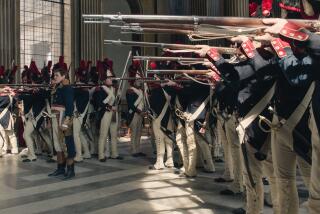‘Battle of Algiers’ Captures Emotions in Both Camps
- Share via
“This dramatic re-enactment of the Battle of Algiers contains not one foot of newsreel or documentary film.” This written message prefaces “The Battle of Algiers,” Gillo Pontecorvo’s film re-creating the often violent events leading up to Algeria’s independence from France in 1962.
Indeed, portions of this remarkably realistic film could very well pass as documentary footage. With its gritty, black-and-white format and roving camera work, “The Battle of Algiers” conveys a sense of history in the making. There’s a sharp edge of immediacy and raw vitality to this 1965 work.
Pontecorvo captures the heated emotions on both sides of the conflict. Though the film was financed by the Algerian government, the Italian filmmaker provides a fair portrayal of both the Algerian Arabs and the French colonialists. During one horrifying segment, we see the bloody aftermath of a French bomb attack on an Arab housing complex. Later on in the film, we’re similarly affected when innocent French citizens are killed during terrorist strikes on several popular cafes.
Even so, it’s easier to sympathize with the indigenous Algerians than it is with the French. When the film enters the Arab quarters of Algiers, there’s an inescapable aura of the Muslims as the oppressed underclass. Even when the Arab populace takes part in a nonviolent eight-day strike, the French army reacts brutally by destroying property and harassing people.
The film portrays the French as unable or unwilling to understand the deep extent of Arab discontent. They are convinced that the uprising can be quelled by eliminating the leadership of the Arab rebel movement, known as the FLN. But in 1960, two years after the rebel high command has been eviscerated, mass rioting erupts in Algiers. The scenes capturing these surging street demonstrations are particularly powerful. Using mobile cameras, Pontecorvo places the viewer right in the thick of the rampaging locals.
But “The Battle of Algiers” comes most intensely alive when it is following the pyramid-shaped FLN, which is constructed so that most members know no more than three people in the organization. Pontecorvo’s striking film offers a fascinating look at the clandestine maneuverings of these insurrectionists.
“The Battle of Algiers” (1965), directed by Gillo Pontecorvo. 123 minutes. Not rated.
More to Read
Only good movies
Get the Indie Focus newsletter, Mark Olsen's weekly guide to the world of cinema.
You may occasionally receive promotional content from the Los Angeles Times.









